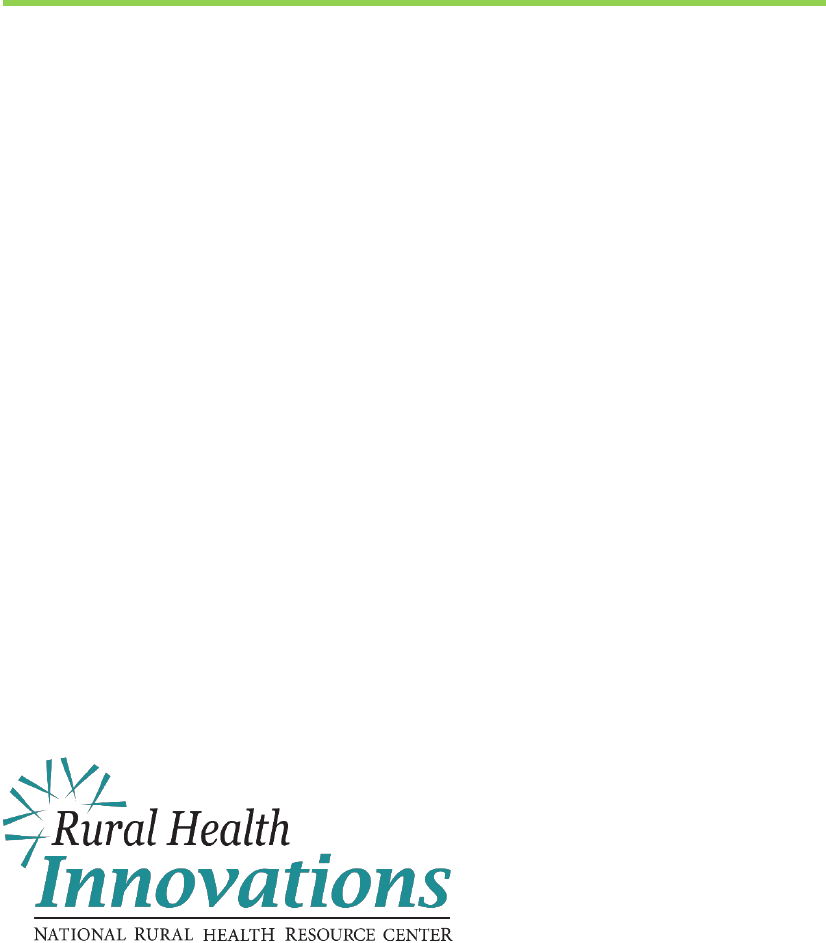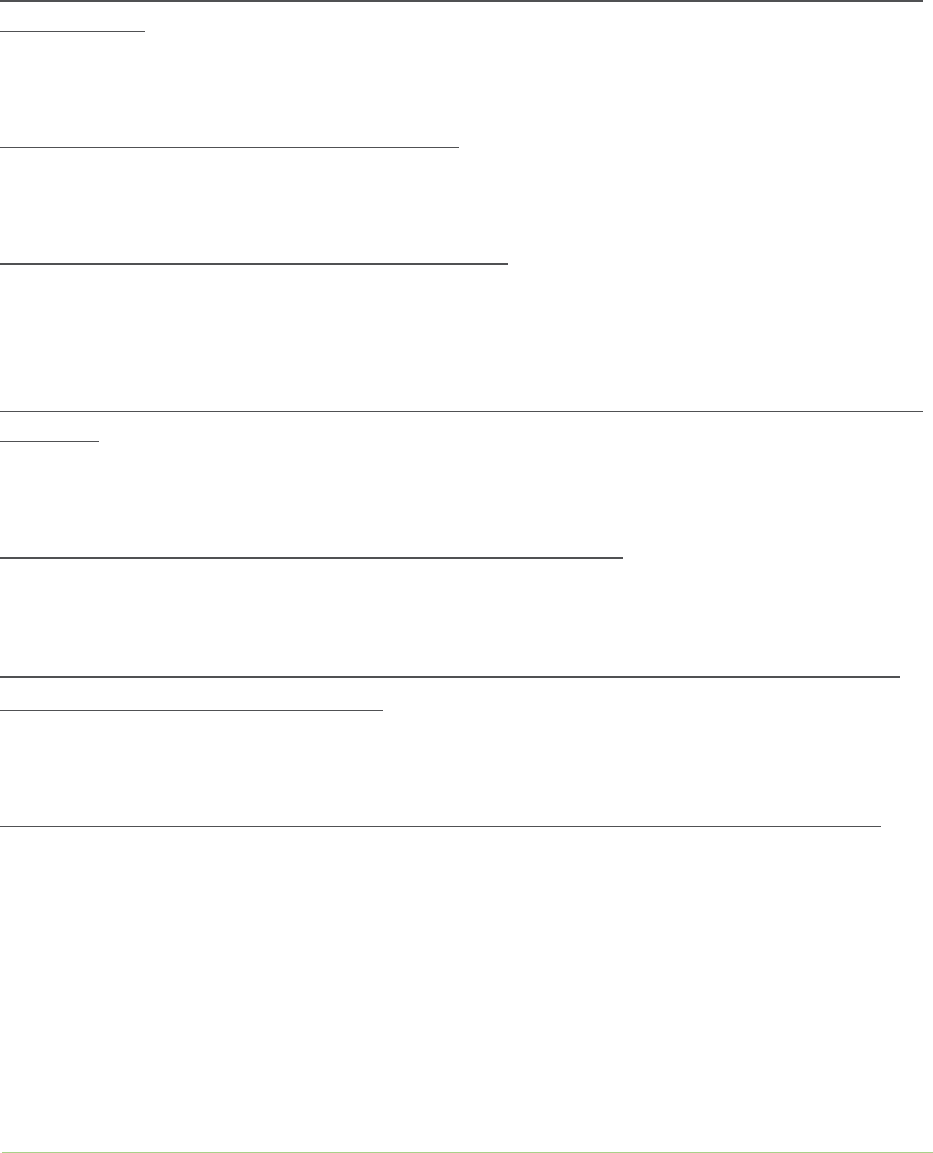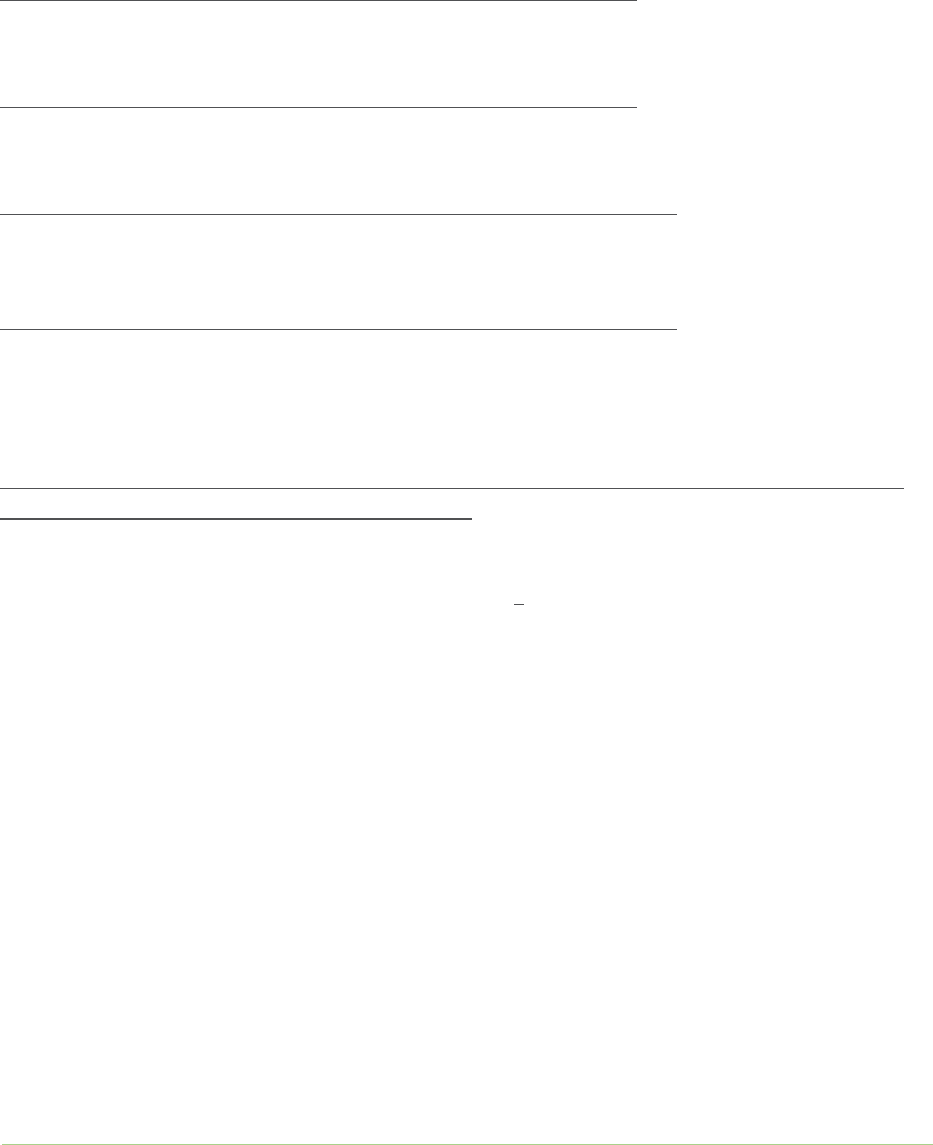
A GUIDE TO WRITING A
PROGRAM EVALUATION PLAN
Rural Allied Health Network Training
Program Technical Assistance
January, 2016
This is a publication of Rural Health Innovations, LLC, (RHI), a subsidiary of the
National Rural Health Resource Center. The Technical Assistance for Network
Grantees Project is supported by Contract Number HHSH250201400024C from the
U.S. Department of Health and Human Services, Health Resources and Services
Administration, Federal Office of Rural Health Policy.

Rural Health Network Program Evaluation Plan Guide
RURAL HEALTH INNOVATIONS 1
TABLE OF CONTENTS
Background and purpose ....................................................................... 1
Getting Started .................................................................................... 2
Critical Evaluation Plan Components ....................................................... 4
1. Program Description ................................................................... 4
2. Evaluation Design ....................................................................... 5
3. Plan to Measure Key Data ............................................................ 6
4. Collecting and Reporting Key Results: ......................................... 11
5. Communication Plan of Key Results ............................................ 11
Resources .......................................................................................... 13
BACKGROUND AND PURPOSE
Rural Health Innovations (RHI), LLC is a subsidiary of the National Rural Health
Resource Center (The Center), a non-profit organization. Together, RHI and The
Center are the nation’s leading technical assistance and knowledge centers in rural
health. In partnership with The Center, RHI enhances the health of rural
communities by providing products and services with a focus on excellence and
innovation. RHI is providing TA to the Allied Health Training Network grantees
through a contract with the federal Office of Rural Health Policy.
Evaluation of grant funded programs is critical to both the success and
sustainability of the program. It is critical to assess impact of the program
objectives to demonstrate value, monitor progress toward the program goals, and
to identify potential best practices and lessons learned. Evaluation results are also
integrated back into the program to improve performance.
This Program Evaluation Plan Guide is designed to support the associated
Evaluation Plan Template to provide guidance to Rural Allied Health Network
Training Program grantees in writing a program evaluation plan. Recorded webinars
are posted on the Aim for Impact and Sustainability network resource webpage and
as a resource in The Center’s online Resource Library.
Content for this Evaluation Plan Guide and the accompanying Evaluation Plan
Template have been adapted from multiple sources, including the Rural Health
Innovations, Evaluation Plan Toolkit for Rural Health Networks, January 2015,
National Rural Health Resource Center Evaluation Toolkit, Alana Knudson, Walsh
Center for Rural Health Analysis, Critical Components of Evaluation and Evaluation

Rural Health Network Program Evaluation Plan Guide
RURAL HEALTH INNOVATIONS 2
Process: Design and Implementation presentation, 2014, John Gail, Maine Rural
Health Research Center Evaluation Workshop, presentation, 2014, Pete Walton,
Oklahoma State Office of Rural Health, Best Practices in Program Evaluation,
presentation, 2014, and Rural Assistance Center online Library. See the Resources
section for helpful links and documents.
GETTING STARTED
Program Evaluation
The purpose of program evaluation is to systematically collect information about
program activities and objectives, monitor progress, and to report and
communicate results to network members, partners, stakeholders, and community.
Spending time consider aspects and components for evaluating a program is well
worth the effort as it saves significant time in the long run. The following are
recommended evaluation plan components:
1. Program Description: Setting context for the evaluation plan including,
program mission, vision, listing of program goals and objectives, network
history and members.
2. Evaluation Design: Describing the purpose and method of evaluation.
3. Plan to Measure Key Data: Selecting key process and outcome data and
identifying specific and defined measurements.
4. Collecting and Reporting Results: Gathering and illustrating program
progress and impact.
5. Communication Plan of Key Results: Intentionally and purposefully
sharing evaluation results with members, partners, community and funders,
that demonstrates success and value.
Planning Framework
Planning for the future can be framed, or understood, from either of two different
planning perspectives:
Identifying the path of action, i.e. objectives or strategies that will lead to
successfully reaching the goal, a general strategic planning approach.
Identifying the expected results, i.e. outcomes of the program that will
illustrate positive progress toward the goal, a specific Logic Model approach.
The difference is due to the frame of reference of the planning approach and is
clearly seen within a chart or diagram that illustrates alignment between the
program goals, objectives, and activities.

Rural Health Network Program Evaluation Plan Guide
RURAL HEALTH INNOVATIONS 3
A strategic planning approach starts with strategies on the far left and works
to the right with measurements of those strategies or targets for identifying
success, and then aligned activities. See Evaluation Plan Sample, for an
example of a generalized strategic planning approach.
A Logic Model approach starts with outcomes on the far right and works to
the left through process outputs toward aligned activities. See Evaluation
Plan Sample for an example of a general Logic Model approach.
Although both approaches are valid ways to approach planning we recommend
selecting one of these two perspectives and then being consistent throughout
development of the evaluation plan.
Program Goals
Generally program goals are articulated within the grant application and will remain
constant during the life of the program or project. These goals are what the
program is aiming for and are often considered the mission and vision of the
program. The overall expectation of evaluation results is to demonstrate
incrementally, positive change (results) toward the program goals.
Program Goal Example: Improving access to health care for children living in
poverty.
Program Objectives
These are the strategies or outcomes expected with achievement of the program
goals. Language is different depending on which planning framework you are
working with.
Generalized Strategic Planning Framework Language:
o Objectives are strategies that describe the high level path that will
lead to program goals. For example, “Creating a coordinated care
process”.
o These strategic objectives are measured in order to monitor progress
toward the program goals.
Logic Model Framework Language:
o Objectives are outcomes that describe the expected success of the
activities. For example, “Coordinated care process for one chronic
disease population”.
o These outcomes are measured in order to monitor progress toward
program goals.

Rural Health Network Program Evaluation Plan Guide
RURAL HEALTH INNOVATIONS 4
Tip: Although it does not matter which planning framework guides the design of
your evaluation plan, it is, however, important to be consistent in the language
used throughout the evaluation plan.
SMART Objectives
One key to successfully evaluating objectives is to have SMART objectives: specific,
measureable, attainable, realistic and timely. It is worth the time and effort to
consider and revise objectives to be SMART.
Sample:
Broad Objective: Everyone is healthy.
SMART Objective: The overall health of the patients in our community with
Diabetes improves within three years.
TIP: If you are using a traditional strategic planning framework, re-write your
strategic objectives into SMART objectives. If you are using a Logic Model planning
framework, re-write your short and mid-term outcomes into SMART objectives.
FAQ: What to do if the objectives are so broad that it is impossible to measure
them?
This is the case when your objectives do not meet the SMART ‘rule of thumb’. If
you are finding your objectives to be un-measurable, our suggestion is to re-write
your objectives by breaking them down into smaller ideas that are SMART
objectives.
CRITICAL EVALUATION PLAN COMPONENTS
Although a specific template for your evaluation plan is not required as part of your
grant deliverable, the following components are recommended. These components
are described in more detail through this Program Evaluation Guide and the
accompanying Evaluation Plan Template.
1. Program Description
Providing context for the evaluation plan is a required component as it sets the
stage for the reader. Remember that the reader of an evaluation plan is primarily
external to the organization. It may be the Board of Directors or Trustees who
most often review evaluation results, however, the primary audience are the
member organizations, community members, potential new members, funding
organizations, etc.
a) Describe the purpose of the program. This may be the mission and vision or
program goals.

Rural Health Network Program Evaluation Plan Guide
RURAL HEALTH INNOVATIONS 5
b) Provide a list of the program’s goals and objectives, i.e. strategies to get to
the expected vision or outcomes.
Tip: Use a numbering system throughout the evaluation plan so that it is
easy for a reader to easily follow specific objectives or outcomes and the
aligned activities, measures, targets between the different sections of the
evaluation plan.
a. Briefly describe the program’s history, including the organizational or
governance structure.
b. List value propositions of each of the program’s products and services.
Tip: A value proposition is developed for each program product or service
and articulates how the member or customer perceives the value of that
product or service. It is important to do this for each product and service
of the program. For example, the value proposition for a 12-week, on-
line certificate program might be: “Provides a quick and flexible solution
for increasing opportunity for employment.”
c. Briefly outline program members and partners and if appropriate, how
specific members or partners are contributing to the program.
Tip: Start with your grant application and develop a program description that is no
more than two pages. It is important for this section to be concise and brief;
providing only information an external reader needs to know to set a context for
the evaluation.
TIP: The program description can be used for other important planning documents
including a strategic plan, marketing plan, communication plan and ultimately your
business plan.
2. Evaluation Design
The design of your evaluation plan is important so that an external reader can
follow along with the rationale and method of evaluation and be able to quickly
understand the layout and intention of the evaluation charts and information. The
evaluation design narrative should be no longer than one page.
There are three basic purposes of an evaluation plan: 1) Tracking progress of the
program’s implementation and execution of the work plan, 2) Monitoring or
studying progress toward the program’s goals by measuring objectives, 3)

Rural Health Network Program Evaluation Plan Guide
RURAL HEALTH INNOVATIONS 6
Communicating results, value, or impact of the program’s achievements and
successes. Describing the evaluation design is important so the external reader can
follow-along with the purpose of the plan and be able to track the connections
between goals, objectives, measures, and activities.
a. Describe the purpose and reason for writing an evaluation plan, tracking
activities and monitoring progress toward program goals, i.e. why is
evaluation important to this program?
b. Identify and describe the planning framework and the reason or rationale;
generalized strategic planning approach or specific Logic Model approach.
o The planning framework being used will influence the language of
your evaluation design and plan. The program objectives are
identified through the planning framework as either strategies or
outcomes.
c. Provide a diagram to illustrate alignment of program objectives
(strategies or outcomes) and key activities with program goals.
o Key activities are those that are considered critical to the success of
the program and have a mid-term timeline of 6-12 months. See the
Strategic Planning & Logic Model Approaches Sample.
Tip:
Be accurate and concise with language based on your planning
framework.
Use an outline or checklist of evaluation plan components to ensure
completeness.
3. Plan to Measure Key Data
A plan to measure key data includes asking questions about implementation
activities and monitoring program impact. Steps include the work of deciding what
key data to measure, identifying specific and defined measurements, and then how
to collect process activity data and objectives outcome and impact data and
eventually when to collect it and who is responsible.
a. Asking Evaluation Questions:
Asking evaluation questions to identify key data is a tried and true approach.
Following are some examples of questions that will assist in identifying key metrics.
What progress has been made toward program implementation?
What progress has been made toward program impact?
What is the impact of the program?
What are opportunities to improve program process for next year?

Rural Health Network Program Evaluation Plan Guide
RURAL HEALTH INNOVATIONS 7
What are opportunities to improve program results?
What has been learned?
What are our best practices?
There are two critical evaluation questions that should be included in any evaluation
plan: “What progress has been made toward the program activities?” and “What
progress has been made toward program objectives?” The following sections
provide examples and suggestions for planning how to measure key data.
b. Tracking Key Implementation Activities:
Program activities are actions and processes put into place to execute objectives.
They help network leaders and stakeholders track the implementation activity of a
program; “What progress has been made toward program
implementation?” Implementation activities are typically identified within the
program work plan. This data is often referred to as ‘outputs’. However, external
readers are primarily interested in the key activities that are aligned with the
program goals and considered critical to the success of the program and that will
demonstrate success of implementation.
Tracking activities include counting historical actions or events, such as,
number of events, participant rate, and number of students, number of
procedures or number of calls.
The language of tracking actions is different based on the planning
framework being used, for example:
Strategic Planning Terminology
o Tracking activities = counting implementation results
o Activity results are typically counted as they identify what has
occurred or transpired
o Activity example and result:
“Start-up a School and Primary Care Task Force”. The task force
met 12 times last year.
Logic Model Terminology
o Tracking activities = counting project outputs
o Activity results create process outputs that can be counted
o Activity example and process output:
“School and Primary Care Task Force meet regularly”. Task Force
met 12 times last year.
Tip: For tracking purposes, select 1-2 mid-term (6-12 month) activities that are
considered critical to the success of the program, and identify one measure for each

Rural Health Network Program Evaluation Plan Guide
RURAL HEALTH INNOVATIONS 8
of the activities. These activities are most likely included within the evaluation plan
diagram that illustrates alignment of the goals, objectives and key activities.
Following is a list of examples of data for measuring implementation activities:
Number of people served or participating
Number of partners or stakeholders involved
Implementation steps completed
Number of resources addressing specific issues available
Number of policy or regulation changes
Certification and graduation rates
c. Monitoring Program Impact:
Program objectives are identified as either strategic objectives or outcomes
depending on the selected planning framework. The data is often referred to as
“achievements” or “outcomes”. External readers are primarily interested in progress
that demonstrates impact of the program goals; E.g. “What progress has been
made on program impact?” In other words, the program efforts are indeed
moving toward the goals. It is this result of the effort that should be measured, i.e.
the achievement.
Monitoring program impact includes identifying expected results, such as,
improved health test results, changes in data for drug use, reduced use of
emergency room, satisfaction results, and increase knowledge based on
test results. .
The language of monitoring impact is different based on the planning
framework being used, for example:
Strategic Planning Terminology
o Monitoring impact = identifying achievements or demonstrating
success
o Achievement example:
“Improved health of community members with diabetes”. The
achievement is seen with 10% improvement of lab results for those
patients over 6 months.
Logic Model Terminology
o Monitoring impact = identifying outcomes
o Outcome example:
“Improved diabetes results within community”. The outcome is of
10% improved lab results over 6 months.

Rural Health Network Program Evaluation Plan Guide
RURAL HEALTH INNOVATIONS 9
Tip: To monitor impact, select 1-2 measures that describe objective impact or
outcome. Within the Logic Model approach, these measurements will be included
as outcomes within the evaluation plan diagram that illustrates alignment of the
goals, objectives and key activities.
Following is a list of data-gathering options related to measuring objectives:
Pre-test/Post-test results, i.e. knowledge or awareness of issues
Surveys/Questionnaires/Checklists for norms, attitudes, and satisfaction
Electronic Health Record clinical results, such as lab results and quality
measurements
Mortality and morbidity numbers
Quality of life scores
Employment rates
d. Tool for Planning How to Measure Key Data:
Describe the plan to identify what data is needed to track process activities that
have been implemented, are in alignment with the program, and monitor progress
on the impact of the program. Utilizing a process to plan for collecting data is
helpful. Following is a suggested list of details to incorporate into a chart. See Plan
to Measure Key Data Sample.
Program Objectives: Include program goal and objective. Limit your
evaluation to no more than two objectives per goal.
What: Measurements that provide evidence of achievement or success for
the specific implementation activity or objective impact. Limit your
measurements to no more than three per objective.
o Describe the measure
o Provide a specific target or benchmark comparison
o Define how the measure will be calculated
o Identify the method of collecting the data
When: Identify timing or frequency of data collection (baseline, quarterly,
annually, funding cycle).
Who: Identify the person who is responsible for gathering data. This person
ensures accuracy and confidentiality.
Tip: Use a numbering system throughout the evaluation plan so that it is easy for
the reader to quickly follow between sections of the evaluation plan, the specific
objectives or outcomes and the aligned activities, measures, targets, etc.

Rural Health Network Program Evaluation Plan Guide
RURAL HEALTH INNOVATIONS 10
e. Quantitative Information vs Qualitative Information:
Quantitative Information includes data that can be counted, for example, claims
data, surveys, clinical results data and public health data. There are many ways to
collect quantitative data. The key is to have a clear understanding of what the
numbers are describing and how they are obtained. This understanding assists in
accurately describing the results and impact.
Qualitative Information is valuable to network leaders and stakeholders as it
provides opportunity through summarized findings, to highlight opportunities for
improvement, lessons learned, potential innovation, and best practices or good
ideas.
Gathering qualitative data includes capturing stakeholder perceptions of
successes and challenges that were experienced during various phases of
the program. Examples of data gathering options may include:
Focus group
Interview
Observation
Analyzing qualitative data requires a systematic approach of grouping or
sorting the information and identifying themes or common categories.
Code data
Group or categorize to identify themes
f. Measuring Complex Information:
Many programs are working to impact large health disparities and complex social-
economic issues. The goals and objectives may be long-term. These long-term
changes and measurement of complex information will possibly need advanced
data analysis. In that case, consider external evaluation when seeking an unbiased
study of a long-term impact of program goals and when broader regional, state, or
national benchmarks are available.
Ensure data is collected consistently at each interval to allow for appropriate data
analysis.
Identify adequate resources for data analysis
Report significant changes based on statistical tests
Identify changes within groups or populations
Use visuals to display analyses (e.g., bar graphs, pie charts, etc.)

Rural Health Network Program Evaluation Plan Guide
RURAL HEALTH INNOVATIONS 11
4. Collecting and Reporting Key Results:
Evaluation results provide a means of demonstrating program progress and impact
to its members and the community. The results are an assessment of the
program’s effectiveness and should be easy for external readers to quickly see and
understand the status of the program in terms of effective implementation and
demonstrating positive change toward the goals and objectives of the program.
The Evaluation Results Scorecard is a chart that includes the result of measures
identified within the Plan to Measure Key Results section of the evaluation plan,
including:
What: Describe the measure and specific target or benchmark
comparison
When: Identify timing or frequency of collecting data (baseline, quarterly,
annually, funding cycle)
Results: What are the collected results or actual data to report
Evaluation Results Scorecard is a tool, in a scorecard format (a Word table or
Excel spreadsheet) to report key evaluation data. See Evaluation Results Scorecard
Sample for illustrating program results and status
Scorecards are tables or spreadsheets that provide an easy-to-read
display of key evaluation results with targets and benchmarks for
comparison.
It is effective to show the result status using color (blue, green, yellow
and red) to indicate success from ‘exceeds targets’ to ‘not meeting
targets’.
Stakeholders can quickly identify those objectives that require
adjustments in actions or measurement.
Tip: Assign one person to be responsible for building and maintaining the
Evaluation Results Chart as it requires routine commitment to updating the charts
to keep them timely and relevant.
5. Communication Plan of Key Results
The purpose of a communication plan is to intentionally and purposefully share
program progress and impact with program members, partners, stakeholders,
community members, and funders. Thinking through a communication plan focuses
network leadership on a critical factor of network development; intentional

Rural Health Network Program Evaluation Plan Guide
RURAL HEALTH INNOVATIONS 12
communication builds trust and credibility between the program and its members
and partners increasing likelihood of program sustainability. The external reader is
interested in understanding how the program plans to communicate its successes
and achievements.
Keep this section to one page of narrative and consider using a diagram or chart to
describe the communication plan. See Evaluation Communication Plan Sample.
Communication Plan Components:
a. Intentionally choose specific evaluation results to demonstrate the
success of the program, i.e. tells the story of your impact and success
b. Be clear on who your audience is, i.e. program staff, board members,
member organization staff, potential partners, funders, community
members, etc.
c. Identify specific mode(s) of delivering the information, i.e. in-person
network board meetings, email, website, SharePoint, phone, formal
reports, discussion, planning retreats, social media, etc.
d. Identify frequency for providing the information, i.e. ad hoc, monthly,
quarterly, in-person only, as requested, etc.
e. Identify the person and their role and responsibilities for communication
accuracy, timeliness, frequency, etc.
Simple and Visual Communication Tools:
Diagrams or charts that provide a simple communication of achievement or
progress toward critical program impact are important communication tools. The
intention is to tell a story about the program and how in meeting its objectives it is
helping to change the world.
Tip:
Use the Evaluation Result Scorecard (chart) to select only 5-10 key results
that are critical for demonstrating the success of the program
Simplify the documentation to include only those key results
Use color and images to provide more insight on the program success
Other information may be included, such as members, key partners, program
goals, objectives, and value propositions.

Rural Health Network Program Evaluation Plan Guide
RURAL HEALTH INNOVATIONS 13
RESOURCES
Evaluation Toolkit and Evaluation Planning
Flex Program Evaluation Toolkit (Technical Assistance and Services Center)
http://www.ruralcenter.org/sites/default/files/Flex%20Program%20Evaluation%20
Toolkit_0.pdf
Evaluating the Initiative (Community Toolbox, University of Kansas)
http://ctb.ku.edu/en/evaluating-initiative
Designing Evaluations (General Accounting Office)
http://www.gao.gov/special.pubs/10_1_4.pdf
The Program Manager’s Guide to Evaluation (Administration for Children and
Families)
http://www.acf.hhs.gov/sites/default/files/opre/program_managers_guide_to_eval
2010.pdf
Evaluating Your Community-Based Program (American Academy of Pediatrics)
https://www2.aap.org/commpeds/htpcp/resources.html
Rural Assistance Center Online Library: Program Evaluation
https://www.ruralhealthinfo.org/topics/rural-health-research-assessment-
evaluation#program-evaluation (will need to copy/paste this link into your browser)
Source: CDC Evaluation Guide: Developing and Using a Logic Model
http://www.cdc.gov/dhdsp/programs/spha/evaluation_guides/logic_model.htm

Rural Health Network Program Evaluation Plan Guide
RURAL HEALTH INNOVATIONS 14
Quantitative and Qualitative Analysis
Analyzing Quantitative Data (University of Wisconsin Extension: Program
Development and Evaluation (1996)
http://learningstore.uwex.edu/Assets/pdfs/G3658-06.pdf
Analyzing Qualitative Data (University of Wisconsin Extension: Program
Development and Evaluation (1996)
http://learningstore.uwex.edu/Assets/pdfs/G3658-12.pdf
Analyzing Quantitative Data for Evaluation (Center for Disease Control and
Prevention, Dept. of Health and Human Services, Evaluation Briefs (2009)
http://www.cdc.gov/healthyyouth/evaluation/pdf/brief20.pdf
Analyzing Qualitative Data for Evaluation (Center for Disease Control and
Prevention, Dept. of Health and Human Services, Evaluation Briefs (2009)
http://www.cdc.gov/healthyyouth/evaluation/pdf/brief19.pdf
Focus Groups
Conducting Focus Groups (Community Tool Box)
http://ctb.ku.edu/en/table-of-contents/assessment/assessing-community-needs-
and-resources/conduct-focus-groups/main
Conducting Focus Groups (Wallace Foundation)
http://www.wallacefoundation.org/knowledge-center/after-school/collecting-and-
using-data/Documents/Workbook-D-Focus-Groups.pdf
